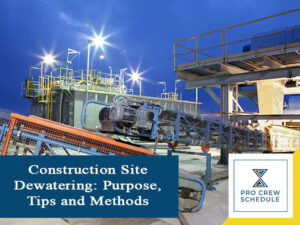Having a suitable construction dewatering plan is crucial in keeping the project within budget and on schedule. While construction site dewatering is both costly and time-consuming, it is necessary to remove and reduce groundwater. Removing groundwater from construction sites is vital for it keeps the workplace safe and protects the materials at the same time. Thus, the proper dewatering plan should be well-prepared, for it could be utilized as compliance of best management practices.
For this article, we will discuss the importance of dewatering in construction, including some tips and methods.
The Main Purpose of Dewatering
Construction dewatering is often used at construction sites due to stored water in excavations and trenches. Accumulated water can also found in any place with an insufficient slope or high water table. For any construction projects, this collected water must be removed in order to maintain the safety at the workplace.
Usually, builders tend to utilize water pumps to dewater any spotted areas. However, problems might occur such as discharges and erosion if they do not pay much attention to the process. It is crucial to follow best construction management practices when groundwater will be pumped to wetlands, lakes, or directly to sewer inlets. By also using a construction scheduling software, monitoring the dewatering process is much easier.
Here are the main purposes of dewatering foundation excavations:
1. Prevent groundwater or soil leakage
If leakage occurs in the excavation area, it will create danger since it can lead to element failure. Some elements are used to support the foundation wall. Hence, it is necessary to dewater the excavation areas to avoid such undesirable results.
Also, the leakage might occur in gravelly or sandy soil with a high groundwater level. Diaphragm walls with improper watertight or bad joints can also lead to leakages. This situation’s primary reason is when water travels by poorly detailed joints and sheet piles that aren’t properly watertight.
2. Prevent sand soiling
When excavation is carried out in gravelly or sandy soil, expect that the groundwater level will be lowered to at least 0.6 meters. If that happens, there will be major differences in the groundwater level between the inside excavation area and outside the excavation zone. If the spotted differences reached the hydraulic gradient of soil, sand boiling would occur.
Prevention of sand boiling is necessary to consider. The recommended solution to solve the sand boiling is to lower the groundwater level right outside the excavation areas. However, care must ultimately be practiced to prevent settlements. Another way to prevent it is to monitor the process using builder trends software. The use of this tool promotes easy scheduling, tracking and monitoring of tasks and crew.
3. Prevent Basement Floatation
The construction of the basement usually starts after the excavation is completed. It will be possible for the basement to experience floatation during the initial stage of the construction. At this particular stage, the weight of the basement might be too small. So, when the upheaval pressure is much greater than the structure’s weight, then the floatation can occur with differential heaves from the foundation.
All phases and stages of the construction are best monitored with the use of construction management software. The tool offers different project management features that improve overall work performance resulting to greater results and advanced project completions.
4. Prevent Upheaval Failure
The groundwater pressure from the layer will pressure the soil layer when the excavation is carried out in clay soil. If the groundwater pressure can overcome the weight of soil layers, upheaval failures will most likely occur. Thus, the prevention of upheaval failure is necessary. In order to avoid this failure, it is required to lessen down the piezometric pressure of the permeable layers. Reducing the pressure is more effective through pumping
Dewatering Tips and Precautions
Any dewatering activities should be done appropriately in order to prevent soil erosion on the construction site. It is also equally important to select the right location for discharge. Dewatering bags, for example, is one of the useful dewatering products that are often used for removing sediments from the pumped water. Below are several dewatering precautions that are needed to follow when selecting discharge areas during the process of dewatering:
· Ensure to choose the right discharge area because it is essential.
· If available, dewatering activities must be directed to a wooded buffer.
· It is imperative to pay extra attention and only to stop dewatering if the areas show signs of erosion.
· Channels utilized during the dewatering process should be stable.
· The channels are much better to be protected with vegetation or grass.
· Avoid discharging water that has already been contaminated with grease, oil or any chemical products.
· Use water/oil separator during the discharging process.
· It is crucial to use a subcontractor scheduling software to track all crew participating crew members.
· During heavy rains, avoid dewatering because the infiltration rate is at the slightest level.
· Additional requirements and permits may be needed from the local, state or federal agencies.
· It is crucial to recognize the water table conditions within the areas.
· The most commonly used dewatering technique is the sump pump, yet it can only handle a smaller water volume.
· Analyze further the water table conditions, especially on the project areas
· Channels used for dewatering should be protected and stable.
When it has been recognized that soils with lower permeability are found, a solution to lessen the dewatering process has been isolating the permeable strata directly from the water sources. Several times, slurry walls, sheet pules and grout curtains can all be used as a technique to avoid water from entering your foundation or trench.
4 Basic Dewatering Methods
Construction dewatering particularly for open trenches and excavations, can be done using a few methods. These different methods available to apply for dewatering aren’t interchangeable. With that being said, each method is distinct from one another and has specific applications. That is why it is crucial to choose the most suitable method for a particular ground condition.
In general, dewatering is known to be a multi-process encompassing storing and pumping the water, discharging and treating it afterward. Depending on the states holding jurisdiction over the construction projects, these steps might require permits. Contractors have to take note that construction dewatering is commonly done before excavation. Thus, dewatering should be done the right way to impede water leakage and help prevent any upheaval failures.
Below are the 4 main construction dewatering methods:
1. Sump pumping
The most common method for dewatering is sump pumping. This type of pumping works by gravity which makes it the most economical. Groundwater will be permitted to seep down into the excavation area where it will be collected in sumps and then pumped it all out.
This method is often applied in shallow excavation areas wherein the soil usually has higher gravel content. If the particular excavation area is huge, this method can be applied using a ditch – a narrow and long sump along with the excavation. During excavation, all working crew is best monitored using crew schedule software. Real-time collaboration and improved communication are best obtained using this advanced tool.
2. Wellpoint
When it comes to well point, a series of wells will be aligned alongside the excavated areas. Riser pipes are where these well points are connected and a vacuum pump and an ordinary header piper. It allows the water to be discharged right away from the construction site. With that process, there will be a sufficient treatment to reduce unwanted materials, especially contaminants.
While the well-point method utilizes suction, it is well-suited for depths that have 5-6 meters. A much deeper drawdown has been requiring multiple stages of well points.
3. Educator Wells
This dewatering method is quite similar to a well point. The only main difference between the two methods is that educator wells utilize high-pressure water instead of vacuum. This dewatering process tends to control pore water pressures, especially on materials with low permeability characteristics like silts and fissured clays.
Technically, this method is applying the venture principle:
The pressure drop draws more water through the riser pipes.
Water under high-pressure is dispersed through educators in the base, creating a pressure reduction.
4. Deep Wellpoint
This method often uses bare holes with a submersible pump to lower the groundwater level below the excavation levels. Wells having diameters between 15 and 20 cm should be drilled around the excavated areas. These excavated areas are where groundwater often falls because of gravity. Hence, it lessens the water table as well as reducing the groundwater in the area.
Casings are utilized in order to retain wells alongside filers and screens. By doing so, keeping sediments out is easier. This particular method is well-suited for construction projects wherein a large amount of water should necessary be removed from the well.
Key Takeaways
Dewatering is definitely a critical consideration for construction projects managers, particularly during excavation and foundation stages. Uncontrolled groundwater can cause floods in any excavated areas, damaging any construction equipment and materials. The accumulated water causes trench collapses as well as threatening the construction crew on site. That is why, before groundwater, it is essential to choose the best dewatering method based on the water table and soil conditions.







